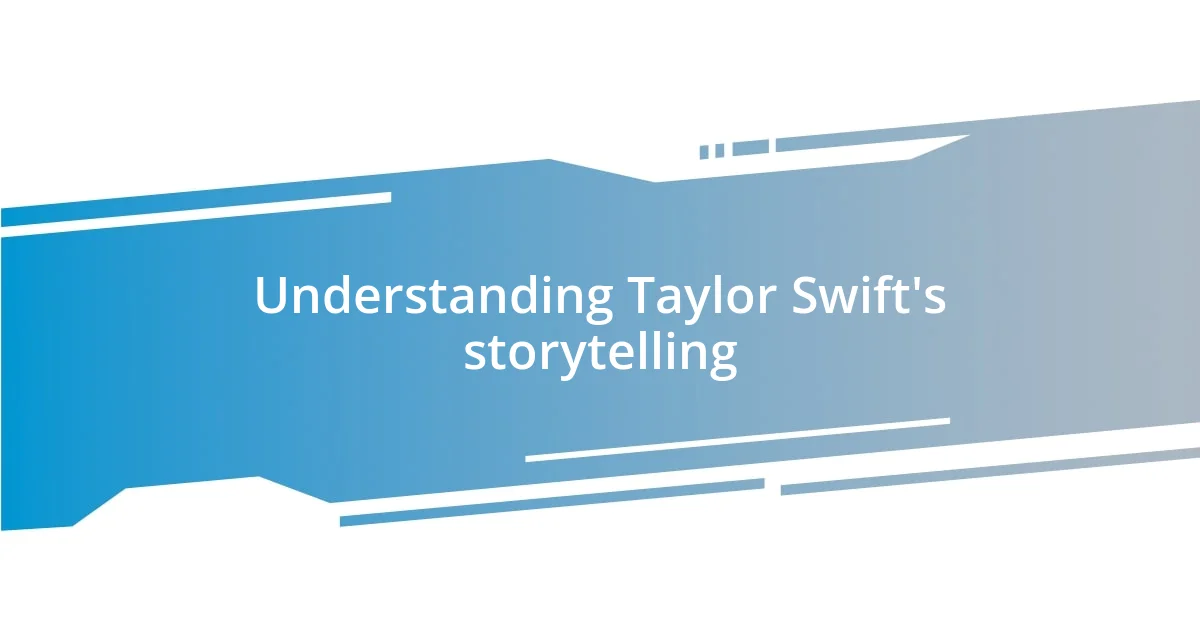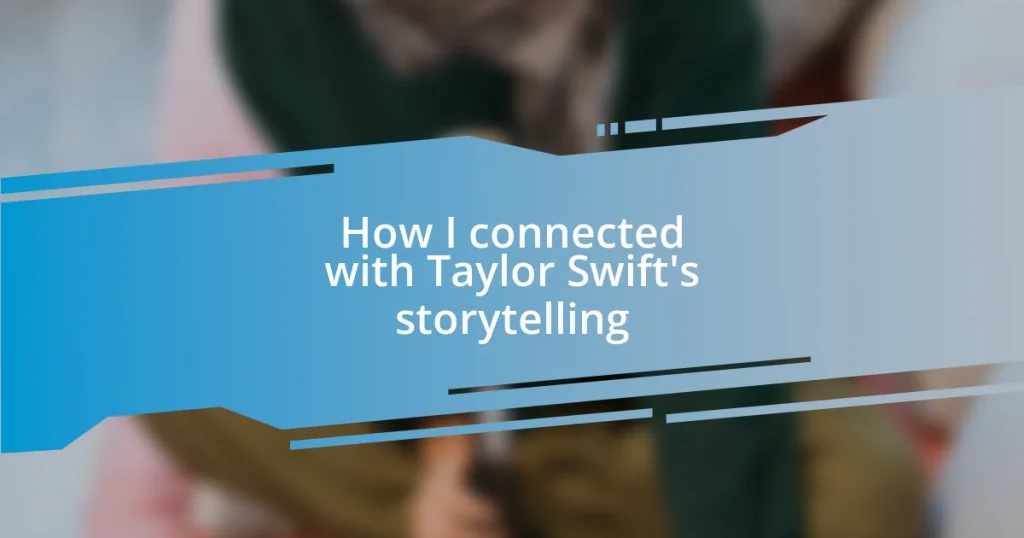Key takeaways:
- Taylor Swift’s storytelling resonates due to its relatable, personal experiences, evoking strong emotions and connections with listeners.
- Her use of narrative techniques like vivid imagery, point of view shifts, symbolism, chronological storytelling, and authentic dialogue enhances the depth and intimacy of her songs.
- Writers can cultivate their own narrative style by embracing authenticity, experimenting with perspectives, and using sensory details to create shared emotional experiences with their audience.

Understanding Taylor Swift’s storytelling
Taylor Swift’s storytelling resonates deeply because it draws on intensely personal experiences, making her narratives feel relatable. I remember the first time I listened to “All Too Well” and how its vivid details transported me to a familiar heartbreak. Can you recall a moment when a song spoke right to your soul? That’s the magic of Taylor’s lyrics—she captures raw, emotional truths that many of us have lived through.
In her songwriting, Swift often adopts the perspective of a storyteller who recognizes the nuances in relationships, conveying the highs and lows with striking clarity. For instance, her ability to illustrate a single moment—a fleeting look or a whispered confession—can evoke vivid emotions. I’ve often found myself lost in her worlds, connecting those lyrical snapshots to my own life experiences. It’s like she hands over pieces of herself, inviting us to explore our own stories alongside hers.
Furthermore, her clever use of metaphors and storytelling techniques transforms everyday situations into striking narratives. When she sings about “the best laid plans,” it’s as if she’s reminding us all of our own dashed dreams—doesn’t that resonate? This combination of relatable themes and poetic devices not only makes her music captivating but also encourages listeners to reflect on their own journeys, creating a powerful bond between Taylor and her audience.

Discovering narrative techniques she uses
Swift employs a range of narrative techniques that elevate her storytelling. One technique I admire is her use of specific imagery, which paints a vivid picture in the listener’s mind. For example, in “The Last Great American Dynasty,” she creates a rich historical backdrop that invites us into the life of Rebekah Harkness, showcasing Swift’s talent for weaving personal and historical stories together. This intricacy pulls me into a narrative that feels both intimate and grand at the same time.
- Vivid Imagery: Swift often uses detailed descriptions to evoke emotions. Think of the way she describes landscapes, seasons, or even a single tear—it’s all about painting a picture.
- Point of View Shifts: I’ve noticed how she sometimes switches perspectives, allowing us to experience a moment from different angles, making the story feel multidimensional.
- Symbolism: Objects and themes reoccur, like scarves in “All Too Well,” which bring a sense of continuity and depth to her narratives.
- Chronological Storytelling: Many songs navigate through time, showing how past experiences influence present emotions, which allows me to reflect on my own life’s moments.
- Authentic Dialogue: I find her use of dialogue in songs like “Cornelia Street” deeply relatable, as it mirrors real conversations, grounding her stories in reality.
Each of these techniques contributes to a feeling of connection—it’s like she’s crafting a conversation between her life and ours. Swift’s brilliance lies in how easily we can see ourselves in her stories, sparking memories and emotions that are genuinely ours.

Creating your own narrative style
Creating your own narrative style is all about finding your unique voice and embracing your experiences. When I first delved into my writing, I realized that the most powerful stories came from a place of authenticity. Have you ever written something that felt so true it resonated deeply with others? I recall sharing a personal story of struggle, and the feedback was overwhelmingly positive. It taught me that vulnerability can cultivate connection.
Exploring different narrative techniques can also enhance your style. I experimented with varying points of view, much like Swift does, and discovered how shifting perspectives added layers to my storytelling. I remember rewriting a piece from the perspective of my younger self, and it transformed the narrative entirely. What we often overlook is that our past can inform our present in astounding ways, adding richness and depth to our tales.
Another exciting aspect is the use of imagery. I learned from Swift’s vivid descriptions to sharpen my own. When I describe a sunset, I aim not just to say it’s beautiful, but to evoke the feeling of warmth wrapping around me as the colors fade. This approach invites readers to feel the moment alongside me. How do you use sensory details in your writing? I’ve found that engaging the senses helps bridge the gap between my experiences and the reader’s imagination, creating a shared narrative space where we can connect.
















